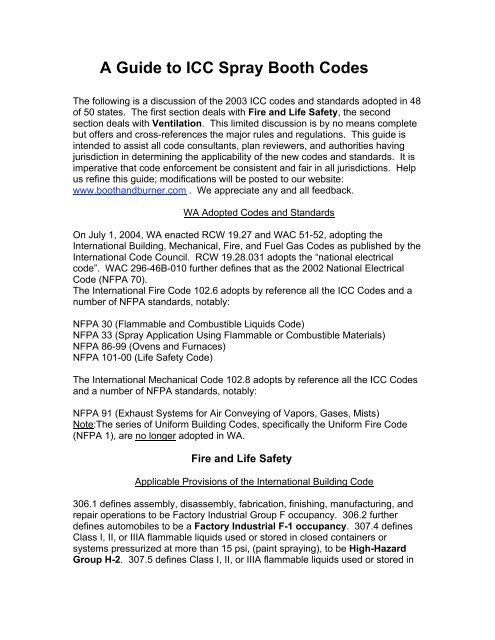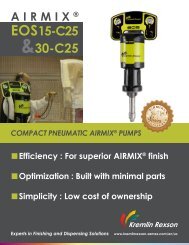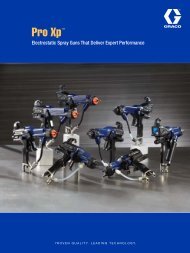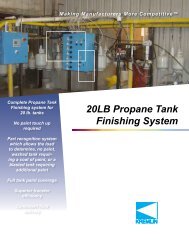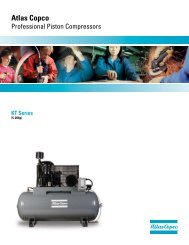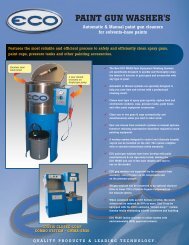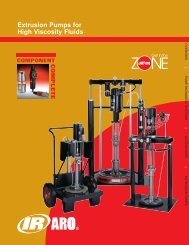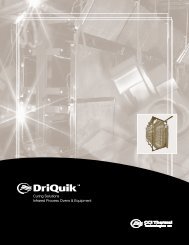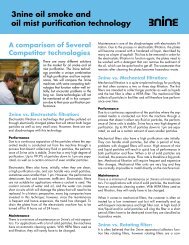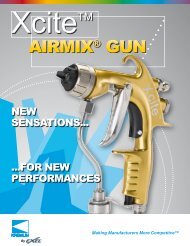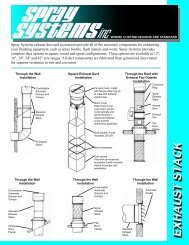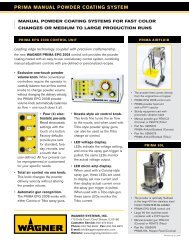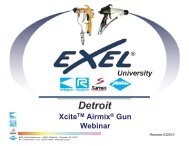A Guide to ICC Spray Booth Codes - Finishing Consultants
A Guide to ICC Spray Booth Codes - Finishing Consultants
A Guide to ICC Spray Booth Codes - Finishing Consultants
You also want an ePaper? Increase the reach of your titles
YUMPU automatically turns print PDFs into web optimized ePapers that Google loves.
A <strong>Guide</strong> <strong>to</strong> <strong>ICC</strong> <strong>Spray</strong> <strong>Booth</strong> <strong>Codes</strong><br />
The following is a discussion of the 2003 <strong>ICC</strong> codes and standards adopted in 48<br />
of 50 states. The first section deals with Fire and Life Safety, the second<br />
section deals with Ventilation. This limited discussion is by no means complete<br />
but offers and cross-references the major rules and regulations. This guide is<br />
intended <strong>to</strong> assist all code consultants, plan reviewers, and authorities having<br />
jurisdiction in determining the applicability of the new codes and standards. It is<br />
imperative that code enforcement be consistent and fair in all jurisdictions. Help<br />
us refine this guide; modifications will be posted <strong>to</strong> our website:<br />
www.boothandburner.com . We appreciate any and all feedback.<br />
WA Adopted <strong>Codes</strong> and Standards<br />
On July 1, 2004, WA enacted RCW 19.27 and WAC 51-52, adopting the<br />
International Building, Mechanical, Fire, and Fuel Gas <strong>Codes</strong> as published by the<br />
International Code Council. RCW 19.28.031 adopts the “national electrical<br />
code”. WAC 296-46B-010 further defines that as the 2002 National Electrical<br />
Code (NFPA 70).<br />
The International Fire Code 102.6 adopts by reference all the <strong>ICC</strong> <strong>Codes</strong> and a<br />
number of NFPA standards, notably:<br />
NFPA 30 (Flammable and Combustible Liquids Code)<br />
NFPA 33 (<strong>Spray</strong> Application Using Flammable or Combustible Materials)<br />
NFPA 86-99 (Ovens and Furnaces)<br />
NFPA 101-00 (Life Safety Code)<br />
The International Mechanical Code 102.8 adopts by reference all the <strong>ICC</strong> <strong>Codes</strong><br />
and a number of NFPA standards, notably:<br />
NFPA 91 (Exhaust Systems for Air Conveying of Vapors, Gases, Mists)<br />
Note:The series of Uniform Building <strong>Codes</strong>, specifically the Uniform Fire Code<br />
(NFPA 1), are no longer adopted in WA.<br />
Fire and Life Safety<br />
Applicable Provisions of the International Building Code<br />
306.1 defines assembly, disassembly, fabrication, finishing, manufacturing, and<br />
repair operations <strong>to</strong> be Fac<strong>to</strong>ry Industrial Group F occupancy. 306.2 further<br />
defines au<strong>to</strong>mobiles <strong>to</strong> be a Fac<strong>to</strong>ry Industrial F-1 occupancy. 307.4 defines<br />
Class I, II, or IIIA flammable liquids used or s<strong>to</strong>red in closed containers or<br />
systems pressurized at more than 15 psi, (paint spraying), <strong>to</strong> be High-Hazard<br />
Group H-2. 307.5 defines Class I, II, or IIIA flammable liquids used or s<strong>to</strong>red in
closed containers or systems pressurized at less than 15 psi, (paint mixing and<br />
s<strong>to</strong>rage), be High-Hazard Group H-3.<br />
Au<strong>to</strong> Body Repair Shops are an F-1 occupancy with allowed H-2 and H-3 areas<br />
within that, per 307.9.3, must comply with Section 416 (Application of Flammable<br />
Finishes), and the International Fire Code.<br />
Table 302.3.2. requires the H-2 areas <strong>to</strong> be separated from F-1 areas by 2 hour<br />
walls, and H-3 areas by one hour walls.<br />
415.3 requires mix rooms larger than 500 square feet <strong>to</strong> be located on an outside<br />
wall. However NFPA 33, 6.3.2 and IMC, 502.8.1.1 limit mixing rooms <strong>to</strong> a<br />
maximum 150 square feet. <strong>Spray</strong> paint booths are excepted from being located<br />
on outside walls.<br />
415.3.1.2. If the combined H-2 and H-3 areas in the F-1 building exceed 1,000<br />
square feet, all building walls must be set back from property lines at least 30<br />
feet.<br />
416.3 requires spraying spaces, spraying areas not in spray rooms or booths <strong>to</strong><br />
be enclosed by curtains. 416.4 requires fire protection in all spray and s<strong>to</strong>rage<br />
rooms.<br />
1033.1.9 and 1008.1.9 require personnel doors in H-2 and H-3 areas <strong>to</strong> be<br />
(cross-bar or push-pad type) panic hardware opened, if the door has <strong>to</strong> have a<br />
latch or lock. Brixon style latches are no longer allowed on personnel doors.<br />
NFPA 101, 7-2.1.8.1 specifies that a door normally required <strong>to</strong> be kept closed<br />
shall be self-closing or au<strong>to</strong>matic-closing. Drive-through doors that are not<br />
required personnel egresses may still have slide bolts and Brixon style latches.<br />
1008.1.6 limits personnel door threshold heights <strong>to</strong> ½ inch.<br />
Table 1018.1 specifies a minimum of 2 exits but Table 1018.2 allows H-2 and H-<br />
3 areas <strong>to</strong> have one exit if there is a maximum travel distance of 25 feet <strong>to</strong> any<br />
exit. Note: the International Fire Code 1015.1 specifies that the travel distance<br />
be “measured from the most remote point” “<strong>to</strong> an exit along the natural and<br />
unobstructed path of egress travel”. The 25 foot rule must consider walking<br />
around an au<strong>to</strong>mobile. This requires nearly all spray booths <strong>to</strong> have two exit<br />
doors. NFPA 101, 7.11.4 (1) requires two means of egress from any hazardous<br />
area over 200 square feet. NFPA 101, 40.2.4.1.1 requires two means of egress<br />
from every section of an industrial occupancy. So, spray booths less than 200<br />
square feet in non-industrial occupancies could have only one personnel door.
Applicable Provisions of the International Fire Code (IFC)<br />
105.6.17 (2.) An operational permit is required <strong>to</strong> s<strong>to</strong>re, handle or use Class I<br />
liquids in excess of 5 gallons.<br />
105.7.7 and 105.7.10 require permits for all spray rooms, booths and ovens.<br />
906 requires minimum 4-A fire extinguishers with a maximum travel distance of<br />
75 feet, located in “conspicuous locations” not “obstructed of obscured from<br />
view”. The extinguishers cannot exceed 40 pounds and be at least 4 inches<br />
above and not over 5 feet from the floor.<br />
Chapter 15 defines Limited <strong>Spray</strong>ing Space, <strong>Spray</strong> <strong>Booth</strong>, and <strong>Spray</strong> Room.<br />
1504 specifies that <strong>Spray</strong> <strong>Booth</strong>s be non-combustible, 18 gage single-skin, 20<br />
gage double-skin, smooth interior surfaces, and personnel doors <strong>to</strong> be a<br />
minimum 30 inches wide and 80 inches high. <strong>Spray</strong> booths are <strong>to</strong> have a clear<br />
space of 3 feet around. <strong>Spray</strong> <strong>Booth</strong>s may be closer <strong>to</strong> or directly against<br />
noncombustible outside walls or one hour rated interior walls.<br />
The aggregate area of <strong>Spray</strong> <strong>Booth</strong>s may not exceed 10% of the building’s area<br />
and no individual <strong>Spray</strong> <strong>Booth</strong> may exceed 1,500 square feet. In very small<br />
buildings, <strong>Spray</strong> <strong>Booth</strong>s 500 square feet or less may exceed the 10% rule.<br />
1504.1.4 and IMC, 502.7.2, a Limited <strong>Spray</strong>ing Space is used for noncontinuous<br />
<strong>to</strong>uch-up or spot painting of a surface area of 9 square feet or less.<br />
No fire protection or explosion venting is required. All wiring 20 feet beyond the<br />
space and within 10 feet of the floor has <strong>to</strong> be Class 1, Division 2.<br />
1504.2.6 and IMC, 502.7.3.6 and 511.2 require exhaust ducts conveying<br />
flammable vapors (defined in the IBC, Section 415, as concentrations exceeding<br />
10% of the solvent’s LFL), fumes, or dusts <strong>to</strong> terminate 30 feet from any property<br />
line and 6 feet above the roof. Exhaust ducts carrying only filtered sanding dust<br />
<strong>to</strong> be 10 feet from the property line and 3 feet above the roof. Environmental air<br />
(no dust, and flammable vapors concentrations less than 10% of the solvent’s<br />
LFL) may exhaust three feet from property lines, no height rule. Environmental<br />
air ducts are not defined in the <strong>ICC</strong> codes. However, for reference, the Uniform<br />
Mechanical Code, 1997, section 502, states: Environmental Air Duct is ducting<br />
used for conveying air … <strong>to</strong> and or from occupied areas … through other than<br />
heating or air conditioning, such as ventilation for human usage… The<br />
environmental air duct setbacks have been improperly used for sanding exhaust<br />
box exhausts.
1504.5.3 allows listed inside-access lights <strong>to</strong> be listed as Class I, Division 2.<br />
1504.6 requires fire protection throughout all spraying areas, exhaust plenums<br />
(including pits), exhaust ducts, and both sides of dry filters.<br />
1504.7.2.1 requires interlocks <strong>to</strong> shut off spraying air during bake cycles, 3<br />
minute minimum purge cycle before baking, and a maximum 200 degrees F. on<br />
the high temperature limit switch.<br />
2103.4 and NFPA 86, 3-1.4.2, and 3-4.3.13 require roofs and floors near bake<br />
booths and hot ducts <strong>to</strong> be insulated and ventilated <strong>to</strong> prevent surface<br />
temperatures of combustible surfaces from exceeding 160 degrees F.<br />
Applicable Provisions of NFPA 33<br />
1.6 defines Limited <strong>Finishing</strong> Workstation, Preparation Workstation, <strong>Spray</strong> <strong>Booth</strong>,<br />
and <strong>Spray</strong> Room.<br />
4.2.1 classifies all spray areas <strong>to</strong> be Class I, Division I locations. 4.3 classifies<br />
specified adjacent areas <strong>to</strong> be Class I, Division 2.<br />
4.5 requires all electrically conductive parts of the spray booth, exhaust ducts,<br />
and spray equipment <strong>to</strong> be electrically bonded and grounded. NFPA 86, 3-2.14,<br />
and 4-1.2 require the metal frames of ovens <strong>to</strong> be grounded. NFPA 91, 5-2.1<br />
specifies bonding and grounding with a resistance less than 1.0 x 10(-6) ohms <strong>to</strong><br />
ground.<br />
5.2.1 requires all overspray filters <strong>to</strong> have visible gauges.<br />
6.3.2 and IMC, 502.8.1.1 limit mixing rooms <strong>to</strong> a maximum 150 square feet and<br />
<strong>to</strong> be designed <strong>to</strong> contain a spill of the contents of the room. Fire protection is<br />
required and all wiring and electrical devices <strong>to</strong> be Class I, Division 1. IMC,<br />
502.8.1.1(5.) Exhaust shall be taken from a point within 12 inches of the floor.<br />
6.3.5 limits mixing room’s flammable liquid quantities <strong>to</strong> 2 gallons per square foot<br />
and spray areas <strong>to</strong> a maximum of 60 gallons. Quantities exceeding these limits<br />
must meet the requirements of NFPA 30.<br />
11.3 <strong>Spray</strong> booths used as ovens must comply with NFPA 86, for Class A<br />
Ovens.<br />
12.2 Preparation Workstations must comply with the requirements of an<br />
unenclosed spray area if they exceed the limitations of a Limited <strong>Finishing</strong><br />
Workstation.
12.3 Limited <strong>Finishing</strong> Workstations must have curtains or partitions, fire<br />
protection, and spray a maximum one gallon of paint per 8 hours.<br />
A.7.2.4 recommends that fire sprinklers in ceilings over spray booths be rated at<br />
286 degrees F. Fire sprinklers inside spray booths and rooms should be no<br />
more that four feet from sidewalls, extra hazard, group 2 design, 90 square feet<br />
max. spacing, max. 12 feet apart including all ductwork, and controlled by a<br />
separate control valve.<br />
Applicable Provisions of NFPA 86 - Ovens and Furnaces<br />
3-2.14 specifies: "The metal frames of furnaces shall be electrically grounded."<br />
This is rarely ever done. With the high air flow, static charges build up and can<br />
ignite flammable vapors.<br />
4-2.2.1 specifies: "The fuel-burning system design shall provide for an adequate<br />
supply of clean combustion air for proper burner operation." Burner air ducting is<br />
often not done by installers on indirect-fire burners that use "flame guns" such as<br />
all Power Flame burners. The burner fans then intake dusty shop air and plug<br />
up.<br />
5-7.2.1 specifies: "Each main and pilot fuel gas burner system shall be separately<br />
equipped with two safety shu<strong>to</strong>ff valves piped in series." This is an old IRI rule<br />
that is now adopted by code. The gas modulating are allowed <strong>to</strong> be one of the<br />
safety shu<strong>to</strong>ff valves if listed <strong>to</strong> do so.<br />
5-8.1 specifies: "A low (fuel) pressure switch shall be provided and shall be<br />
interlocked with the combustion safety circuitry." Many heaters are supplied with<br />
a high fuel pressure switch only.<br />
Applicable Provisions of NFPA 91 – Exhaust Systems<br />
2-3.1 requires exhaust ducts subject <strong>to</strong> particulate build-up <strong>to</strong> have access doors<br />
at all elbows, junctions, and vertical ducts, and door spacing shall not exceed 12<br />
feet.<br />
2-6.1 and IMC, 510.8.2 require exhaust ducts handling flammable vapors and/or<br />
combustible material, with fire protection, <strong>to</strong> maintain 6 inches clearance from<br />
combustibles unless protection specified in Table 2-6.1 is used.<br />
2-6.2 specifies that exhaust ducts operating at temperatures above 140 degrees<br />
F. shall have clearances from combustibles of not less than 18 inches, no<br />
exceptions listed. Non-recirculating bake booths would have <strong>to</strong> comply with this<br />
rule for any exhaust ducts used for bake exhaust.<br />
6-1 and IMC, 510.7 allow no fire protection for exhaust ducts of 10” or less dia.
Application of the International Fuel Gas Code<br />
The International Mechanical Code, 101.2 and 301.3 states: “……..fuel gas-fired<br />
appliances ………shall be in accordance with the International Fuel Gas Code.”<br />
International Fire Code (IFC), Section 1504, <strong>Spray</strong> <strong>Finishing</strong>, 1504.1.2 <strong>Spray</strong><br />
booths. “The design and construction of spray booths shall be in accordance<br />
with ……., and NFPA 33.”<br />
NFPA 33, A.11.3, “When a spray booth or spray room is used for drying or curing<br />
at elevated temperatures in accordance with Section 11.3, it is considered a<br />
“Class A” oven or furnace …….”<br />
IFC, Section 1504, <strong>Spray</strong> <strong>Finishing</strong>, 1504.7.2 Drying apparatus. “Fixed drying<br />
apparatus shall comply with this chapter and the applicable provisions of Chapter<br />
21. (Industrial Ovens)<br />
IFC, Chapter 21, Industrial Ovens, Section 2101, 2101.1, Scope. (Industrial<br />
ovens …. shall comply with …..the International Fuel Gas Code…….” 2102.1<br />
Definitions. Furnace Class A. “An oven or furnace that has heat utilization<br />
equipment ……. wherein there is a potential explosion or fire hazard that could<br />
be occasioned by the presence of flammable volatiles or combustible materials<br />
processed or heated in the furnace.” “Note: Such flammable volatiles or<br />
combustible materials can, for instance, originate from the following: 1. Paints<br />
……. from finishing processes, such as ……sprayed and impregnated materials.”<br />
WA Administrative Code 51-52-0101 states: “The installation of ……fuelgas<br />
fired appliances…….shall be regulated by the International Fuel Gas Code.”<br />
(IFGC)<br />
These codes establish that a spray booth with a heater, whether for spraying or<br />
baking, is a Class A oven, and must comply with the International Fuel Gas<br />
Code.<br />
Applicable Provisions of the International Fuel Gas Code<br />
101.2 Scope. “This code shall apply <strong>to</strong> the installation of ……fuel-gas utilization<br />
equipment and related accessories……”<br />
101.2.3 Gas utilization equipment. “Requirements for gas utilization equipment<br />
and related accessories shall include installation, combustion and ventilation air<br />
and venting and connections <strong>to</strong> piping systems.”<br />
301.3 Listed and Labeled. “Appliances regulated by this code shall be listed and<br />
labeled unless otherwise approved in accordance with Section 105.” Section 105<br />
variously states: “……the code authority shall have the authority <strong>to</strong> grant
modifications for individual cases, provided the code official shall first find that<br />
special individual reason makes the strict letter of this code impractical and that<br />
such modification …….does not lessen health, life, and safety requirements.”<br />
The listed/unlisted issue is not a “strict letter” technicality-type issue. The listed<br />
requirement is fundamental and important enough <strong>to</strong> be the first regulation of the<br />
International Fuel Gas Code.<br />
Modification, by waiving the listing, requires that there be a “special individual<br />
reason making the strict letter of the code impractical”. With dozens of listed<br />
spray booths with heaters for sale, the “special individual reason” has <strong>to</strong> be that<br />
the buyer chose not <strong>to</strong> pay extra for a listed spray booth with heater. The buyer’s<br />
purchasing choice made the requirement for listing “impractical”, <strong>to</strong> the buyer<br />
only.<br />
301.3 further states: “The approval of unlisted appliances in accordance with<br />
Section 105 shall be based upon approved engineering evaluation.” showing that<br />
modification of the requirement for a listed spray booth with heater “does not<br />
lessen health, life, and fire safety requirements.” (105.1) The burden of code<br />
compliance proof and costs for an “engineering evaluation” is the buyers, having<br />
chosen an unlisted spray booth with heater.<br />
WA RCW 18.43.020 Definitions (5) “Practice of engineering: ……such<br />
professional services ….. as…….evaluation……for the purpose of assuring<br />
compliance with specifications and design in connection with any<br />
……..equipment……” “A person shall be construed <strong>to</strong> practice<br />
……engineering……represents himself or herself <strong>to</strong> be a professional engineer.”<br />
(2) “…..as attested by his or her legal registration as a professional engineer.”<br />
We add this as a booth manufacturer publishes a letter, trying <strong>to</strong> avoid the<br />
requirement for listing, that is signed by their “engineer/technician”.<br />
Ventilation<br />
IFC 1504.2.3 and IMC, 502.7.3.3 require a minimum average air velocity of 100<br />
feet per minute across the direction of air flow of all spraying operations. All<br />
Limited <strong>Finishing</strong> Workstations, Preparation Workstations, <strong>Spray</strong> <strong>Booth</strong>s, and<br />
<strong>Spray</strong> Rooms:<br />
NFPA 33,1.6.29 and 5.2 and NFPA 91, 2-1.3 and IMC, 510.3 require enough<br />
ventilation <strong>to</strong> maintain a maximum concentration of flammable vapors <strong>to</strong> 25% of<br />
the LFL.<br />
NFPA 33, 6.3.2 and IMC, 502.8.1.1 require mixing room ventilation <strong>to</strong> be “in<br />
operation at all times” and <strong>to</strong> be a minimum 150 cfm.
IMC, 503.2 requires all exhaust fan parts that come in contact with flammable<br />
vapors, fumes, or dusts shall be of nonferrous or non-sparking materials and that<br />
the fan bearings shall not be within the airstream. This outlaws squirrel-cage<br />
fans as exhaust fans.<br />
Note: the following rules pertain <strong>to</strong> all uncontained spraying operations. For full<br />
cabin, contained air, <strong>Spray</strong> <strong>Booth</strong>s, see above.<br />
IFC 1504.1.4.3 and IMC, 502.7.2, Limited <strong>Spray</strong>ing Space ventilation is required<br />
at 6 air changes per hour.<br />
NFPA 33, 12.2 Preparation Workstations must comply with the requirements of<br />
an unenclosed spray area if they exceed the limitations of a Limited <strong>Finishing</strong><br />
Workstation.<br />
NFPA33,12.3 Limited <strong>Finishing</strong> Workstations must have a dedicated make-up air<br />
supply and plenum, and a dedicated mechanical exhaust and filtration.<br />
NFPA33,A.5.3 Make-up Air. All spray areas require make-up air (See IMC<br />
510.5.5) Natural infiltration ventilation is allowed, but additional make-up air<br />
should be provided if the volume of the building is not at least 20 times the<br />
volumetric capacity of the exhaust fans (that are capable of three air changes per<br />
hour in the spray area and per IFC 1504.2.3 and IMC, 502.7.3.3: an average air<br />
velocity of 100 feet per minute across the direction of air flow.). Example: 10,000<br />
cfm (exhaust fan) x 20 = 200,000 cubic foot building, if the roof height were 15<br />
feet, the minimum floor area for natural ventilation would be 13,334 square feet.<br />
A smaller building requires mechanical make-up air ventilation. Also, it is<br />
recommended that all intake and exhaust filters be baffled <strong>to</strong> prevent more than<br />
200 feet per minute velocity through any filter. Note: these appendix "shoulds"<br />
can be "shalls" at the prerogative of the code official and should be presumed <strong>to</strong><br />
be required unless specifically allowed by the code official.<br />
IMC, 508.1.1 Makeup air temperature. The temperature differential between<br />
makeup air and the air in the conditioned space shall not exceed 10° F. Note:<br />
this rule pertains <strong>to</strong> Commercial Kitchen Makeup Air, however as no other<br />
specific rule pertains <strong>to</strong> spraying operations, it may be applied by the code official<br />
by authority of IMC 102.9: Requirements not covered. This rule requires a<br />
heated air makeup unit except where "makeup air does not decrease the comfort<br />
conditions of the occupied space".<br />
NFPA 33, 6.3.2 and IMC, 502.8.1.1 require mixing room ventilation <strong>to</strong> be “in<br />
operation at all times” and <strong>to</strong> be a minimum 150 cfm.<br />
IMC, 501.3 specifies that where mechanical exhaust is required that the<br />
ventilated space "shall be maintained with a neutral or negative pressure". This
equires that make-up air sizing be such that ex-filtration of dust or fumes does<br />
not occur in<strong>to</strong> adjoining areas.<br />
NFPA 91 – Exhaust Systems, Table A-2-1.5 suggests exhaust duct diameter<br />
sizing <strong>to</strong> allow 1,000-2,000 feet per minute velocity.


